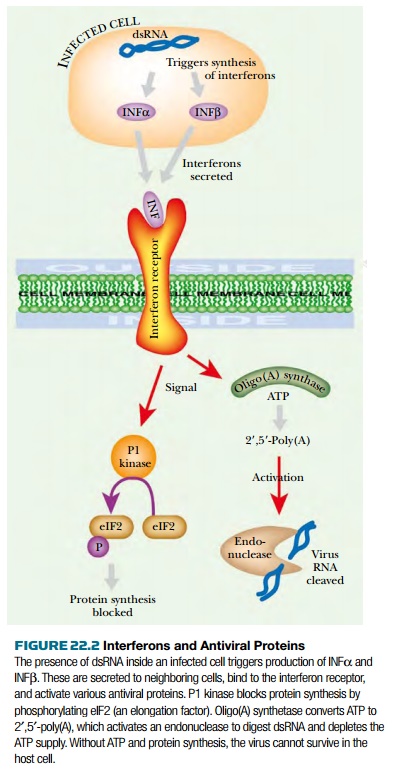Chapter: Biotechnology Applying the Genetic Revolution: Viral and Prion Infections
Interferons Coordinate the Antiviral Response
INTERFERONS
COORDINATE THE ANTIVIRAL RESPONSE
Interferons are a class of proteins
induced in animal cells in response to virus infection. Clinical treatment with
interferons is used to treat viral infections in a few cases (e.g., against
hepatitis B and hepatitis C infections). Interferons α and β ( INF α and
INF β ) block the spread of viruses by interfering with virus
replication. (Although interferon γ shares the same name, it is quite
distinct and is not induced directly by virus infection. It has a regulatory
role in response to intracellular pathogens.) Interferons α and β are
secreted in response to double-stranded RNA, which is symptomatic of the
replication of most RNA viruses. They bind to the interferon receptors of both
the infected cell itself and its neighbors. Locally, this triggers a
phosphorelay signal pathway that activates several genes involved in opposing
virus infection ( Fig. 22.2 ).

Antiviral proteins induced by interferon include oligoadenylate synthetase, which converts ATP into 2′-5′-linked poly(A). This removes the ATP required as an energy source for viral replication. In addition, 2′- 5′-poly(A) activates an endonuclease that cleaves viral RNA. P1 kinase is also activated and phosphorylates initiation factor eIF2, halting protein synthesis. The Mx proteins are GTPases that probably interfere with the RNA polymerases of negative-strand RNA viruses (e.g., influenza, parainfluenza). Interferons also help activate immune system cells, such as NK cells, which selectively destroy virus infected cells.
Interferon alpha was one of the first
mammalian proteins to be manufactured via genetic engineering. However, its
clinical effects have been disappointing except in a few cases. Modern attempts
at antiviral therapy have tended to move away from interferons and toward stimulating
the RNA interference system.
Related Topics